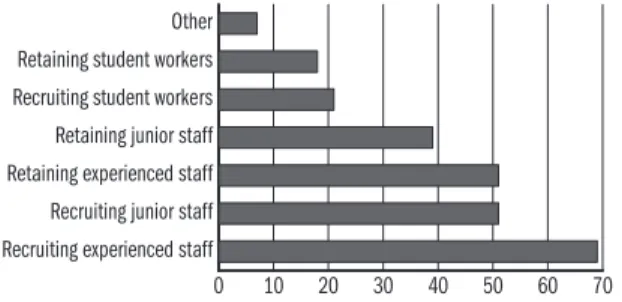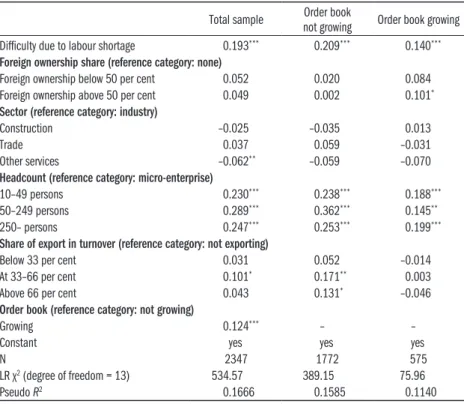3 RECRUITMENT DIFFICULTIES, BUSINESS OPPORTUNI- TIES AND WAGES – ENTERPRISE-LEVEL ANALYSIS
3.1 ENTERPRISES COMPLAINING ABOUT RECRUITMENT DIFFICULTIES
István János Tóth & Zsanna Nyírő
The present analysis, based on an empirical business survey, which collected data from the leaders of 3,185 firms,1 examines the proportion and charac- teristics of firms facing labour shortage and discusses how labour shortage relates to the expected investment, the order book and the forecast wage in- crease of the firms concerned.
Difficulties in recruiting and retaining staff
About one in ten firms mentioned labour and skill shortage as an obstacle to business activity (recruitment difficulties) in the business surveys conducted between April 2011 and October 2013. Then this proportion rose sharply in October 2014 (to 21 per cent): every fifth firm regarded this problem as one of the three major obstacles to business activity. There was another substan- tial increase in October 2015, when 27 per cent of firms reported labour and skill shortages. One year later already 36 per cent of firms, and in April 2017, 38 per cent of firms mentioned this problem (Nábelek et al., 2017).
In addition to the usual question of the business surveys (“What factors have limited the business activity of your company the most in the past six months?
Please choose a maximum of three answers.”), another, more general question on labour shortage was included in October 2016: “Has your company faced any difficulties resulting from labour shortage in the previous 12 months?” This question was answered by 2,647 company leaders and 53 per cent (1,392 com- pany leaders) answered “yes”. It was mainly exporting (74 per cent), industrial (67 per cent) and mostly foreign-owned (76 per cent) firms, those from Trans- danubia (53 per cent) as well as medium (78 per cent) and large businesses (85 per cent) that reported labour shortage as a problem for their companies.
As for difficulties resulting from labour shortage, the recruitment of expe- rienced staff presented a problem for most companies (69 per cent). Recruit- ing junior staff and retaining more experienced staff caused difficulties for about a half of the respondents (51–51 per cent). More than one-third of respondents (39 per cent) even found it difficult to retain junior staff, one- fifth of firms struggled to recruit student workers (for example trainees) (21 per cent) and retain trainees (18 per cent). 7 per cent of respondents selected another factor (Figure 3.1.1).
Nearly two-thirds of respondents (64 per cent) thought that labour short- age-related problems would worsen in 2017 in Hungary, about one-third of
1 The analysis relied on publicly available data of the Institute for Economic and Enterprise Research (IEER) of the Hungar- ian Chamber of Commerce and Industry. For the first version of the analysis see: Nábelek et al. (2017).
0 10 20 30 40 50 60 70 Recruiting experienced staff
Recruiting junior staff Retaining experienced staff Retaining junior staff Recruiting student workers Retaining student workers Other
them (31 per cent) thought they would remain the same and only 5 per cent of them thought that these difficulties would abate.
Figure 3.1.1: The distribution of respondents according to the situations in which their companies faced difficulties resulting
from labour shortage in October 2016 (per cent)
Note: N = 1255.
Source: Institute of Economic and Enterprise Research (IEER), Busi- ness Climate Survey, October 2016.
Multivariable analysis
The occurrence of labour shortage as a problem was assessed using a logit model. We aimed at finding out which companies face this problem more frequently and how the perception of labour shortage relates to the situa- tion in business, the expectations and the order book of firms. It is possi- ble that there are no relationships between them: that labour shortage is so general that it concerns heterogeneous groups of firms. If the problem is more characteristic of companies with a bad situation in business, poor prospects and stagnating order books, it probably concerns weaker compa- nies unable to increase their turnover. If, however, there is a positive rela- tionship between labour shortage and the situation in business and expec- tations concerning it, then labour shortage is more likely to affect firms that would otherwise be able to increase their turnover and profit. As for business characteristics, the sector, the size of firms, the proportion of ex- ports within total turnover and the share of foreign ownership in registered capital were taken into account.
The findings (Table 3.1.1) clearly indicate that labour shortage in 2016 typically emerged among companies that considered their prospects good, had positive expectations for 2017 and expected their order books to grow.
8–10 percentage points more firms with a good or acceptable situation in business experienced labour shortage than firms in a bad situation in busi- ness. There is a weaker relationship with the expected situation in business:
6 percentage points more companies expecting a positive business situa- tion reported this problem than companies expecting a deteriorating situ- ation in business.
A considerable difference was also observed according to the order book:
an 8 percentage point higher proportion of firms with growing order books reported recruitment difficulties, compared to firms which expected a stag- nating or decreasing order book.
Table 3.1.1: “Has your company faced any difficulties resulting from labour shortage in the previous 12 months?”
October 2016, logit estimation, average marginal effects
(1) (2) (3)
Foreign ownership share (reference category: no foreign ownership)
Foreign ownership: below 50 per cent 0.028 0.033 0.019
Foreign ownership: above 50 per cent 0.039 0.027 0.036
Sector (reference category: industry)
Construction industry 0.154*** 0.152*** 0.154***
Trade –0.055 –0.062* –0.059*
Other services –0.082*** –0.088*** –0.087***
Headcount (reference category: micro-enterprise)
10–49 persons 0.294*** 0.307*** 0.299***
50–249 persons 0.358*** 0.360*** 0.367***
250– persons 0.434*** 0.422*** 0.434***
Share of export within turnover (reference category: no export)
Below 33 per cent 0.057* 0.047 0.047
At 33–66 per cent 0.043 0.049 0.032
Above 66 per cent 0.101** 0.123** 0.091*
Current situation in business (reference category: bad)
Satisfactory 0.080*** – –
Good 0.098*** – –
Expected situation in business (reference category: bad)
Satisfactory 0.032 –
Good 0.063** –
Order book (reference category: not growing)
Increases 0.081***
Constant yes yes yes
N 2414 2345 2459
LR χ2 (degree of freedom = 13) 462.75 455.19 478.77
Pseudo R2 0.1384 0.1401 0.1407
Note: Dependent variable: difficulty due to labour shortage, 0 – no, 1 – yes.
*** Significant at a 1 per cent level, ** significant at a 5 per cent level, * significant at a 10 per cent level.
The phenomenon was not restricted to the manufacturing industry; in fact, it was more marked in the construction industry and services sector than in manufacturing. A 15 percentage point higher proportion of construction companies reported labour shortage than manufacturing companies. Com- pared to micro-enterprises (firms employing 1–9 persons), companies of all other sizes perceived labour shortage as a problem more frequently. However, exporting and foreign ownership did not play a significant role.
Recruitment difficulties and wage increase intentions
It seems obvious to assume that firms facing labour shortage respond to it – among others – by raising wages. We examine in the following section wheth- er firms reporting labour shortage in 2016 intended to raise wages in 2017.
The findings of the October 2016 survey indicate that 55.4 per cent of firms (1477 of the 2665 firms included) intended to increase wages in 2017.
We have controlled for the ownership structure, sector, size (headcount) and the share of exports in the turnover of companies and also took the busi- ness expectations of companies into consideration. The latter were assessed by the expected changes in the order book. It can be assumed that companies with better business expectations are more likely to increase wages than those with deteriorating or stagnating prospects. Accordingly, firms which are able to increase their order books are more likely to plan wage increases. Accord- ing to the results of business surveys to date, a higher proportion of export- ing and foreign-owned firms as well as firms other than micro-enterprises had good business expectations and wage increase intentions. These factors are also worth considering when investigating links between labour shortage and wage increase intentions. In order to be able to evaluate the effect of labour shortage independent of the above factors, logit estimation was conducted.
Because of the positive correlation between the expectations concerning the order book and the perception of labour shortage seen in Table 3.1.1 the es- timation was carried out not only for the total sample but also for the sub- samples including companies expecting an increase and those not expecting an increase in the order books.
The findings presented in Table 3.1.2 show that there is a significant positive relationship between perceiving labour shortage and the intention of firms to raise wages: a 19 percentage point larger proportion of companies facing labour shortage in 2016 intended to increase salaries in 2017.
As presumed, the proportion of firms planning to increase wages is signifi- cantly higher among those expecting their order books to increase than among those expecting stagnation or fall. It is also clear that recruitment difficulties have a stronger impact on the forecast wage increases of firms not expecting their order books to grow than those expecting it. It increases the probability of a wage increase by 21 percentage points in the former group and only by 14 percentage points in the latter.
The sample analysed herein is not suitable for examining to what extent the wage increases materialised – it will be presented in Subchapter 3.3, rely- ing on a smaller sample, that the relationship between plans and actual out- comes is rather loose.
In conclusion, the findings suggest that it is mainly successful companies that report difficulties in recruiting and retaining staff, which is partly an inherent feature of the growth necessary for fulfilling an increased volume of orders.
Table 3.1.2: The estimation of wage increase intentions, October 2016, logit estimation, average marginal effects
Total sample Order book
not growing Order book growing Difficulty due to labour shortage 0.193*** 0.209*** 0.140***
Foreign ownership share (reference category: none)
Foreign ownership below 50 per cent 0.052 0.020 0.084
Foreign ownership above 50 per cent 0.049 0.002 0.101*
Sector (reference category: industry)
Construction –0.025 –0.035 0.013
Trade 0.037 0.059 –0.031
Other services –0.062** –0.059 –0.070
Headcount (reference category: micro-enterprise)
10–49 persons 0.230*** 0.238*** 0.188***
50–249 persons 0.289*** 0.362*** 0.145**
250– persons 0.247*** 0.253*** 0.199***
Share of export in turnover (reference category: not exporting)
Below 33 per cent 0.031 0.052 –0.014
At 33–66 per cent 0.101* 0.171** 0.003
Above 66 per cent 0.043 0.131* –0.046
Order book (reference category: not growing)
Growing 0.124*** – –
Constant yes yes yes
N 2347 1772 575
LR χ2 (degree of freedom = 13) 534.57 389.15 75.96
Pseudo R2 0.1666 0.1585 0.1140
Note: dependent variable: intended wage increase in 2017, 0 – no, 1 – yes.
*** Significant at a 1 per cent level, ** significant at a 5 per cent level, * significant at a 10 per cent level.
Reference
Nábelek Fruzsina–Hajdu Miklós–Nyírő Zsanna–Tóth István János (2017): A munkaerőhiány vállalati percepciója. Egy empirikus vizsgálat tapasz- talata. (Business perception of labour shortage. Findings of an empirical survey) IEER, Budapest.


